Events
| | This section needs expansion. You can help by adding to it. (October 2015) |
| Years in Poland: | 1788 1789 1790 1791 1792 1793 1794 |
| Centuries: | 17th century · 18th century · 19th century |
| Decades: | 1760s 1770s 1780s 1790s 1800s 1810s 1820s |
| Years: | 1788 1789 1790 1791 1792 1793 1794 |
Events from the year 1791 in Poland
| | This section needs expansion. You can help by adding to it. (October 2015) |
| | This section needs expansion. You can help by adding to it. (October 2015) |
| | This section needs expansion. You can help by adding to it. (October 2015) |
"The dominant national religion is and shall be the sacred Roman Catholic"
Roman catholic

The Partitions of Poland were three partitions of the Polish–Lithuanian Commonwealth that took place toward the end of the 18th century and ended the existence of the state, resulting in the elimination of sovereign Poland and Lithuania for 123 years. The partitions were conducted by the Habsburg monarchy, the Kingdom of Prussia, and the Russian Empire, which divided up the Commonwealth lands among themselves progressively in the process of territorial seizures and annexations.
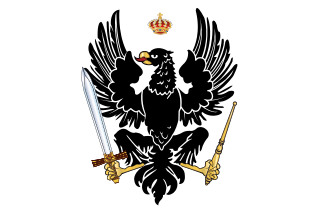
The Kingdom of Prussia constituted the German state of Prussia between 1701 and 1918. It was the driving force behind the unification of Germany in 1866 and was the leading state of the German Empire until its dissolution in 1918. Although it took its name from the region called Prussia, it was based in the Margraviate of Brandenburg. Its capital was Berlin.

A state religion is a religion or creed officially endorsed by a sovereign state. A state with an official religion, while not a secular state, is not necessarily a theocracy. State religions are official or government-sanctioned establishments of a religion, but the state does not need to be under the control of the clergy, nor is the state-sanctioned religion necessarily under the control of the state.

An edict of toleration is a declaration, made by a government or ruler, and states that members of a given religion will not suffer religious persecution for engaging in their traditions' practices. Edicts may imply tacit acceptance of a state religion.

The Polish–Lithuanian Commonwealth, formally known as the Kingdom of Poland and the Grand Duchy of Lithuania, or simply Poland–Lithuania, was a bi-confederal state, sometimes called a federation, of Poland and Lithuania ruled by a common monarch in real union, who was both King of Poland and Grand Duke of Lithuania. It was one of the largest and most populous countries of 16th- to 17th-century Europe. At its largest territorial extent, in the early 17th century, the Commonwealth covered almost 1,000,000 km2 (400,000 sq mi) and as of 1618 sustained a multi-ethnic population of almost 12 million. Polish and Latin were the two co-official languages, and Roman Catholicism served as the state religion.

Wawrzyniec Goślicki was a Polish nobleman, Bishop of Poznań (1601–1607), political thinker and philosopher best known for his book De optimo senatore (1568).

The Crown of the Kingdom of Poland was a political and legal idea formed in the 14th century, assuming unity, indivisibility and continuity of the state. According to this concept, the state ceased to be the patrimonial property of the monarch or dynasty, but became a common good of the political community of the kingdom. Such an idea allowed the state to function even in periods of interregnum and led to the formation of a system characteristic of Poland based on the parliamentarism of the nobility and the free election of the ruler. At the same time, the idea of the crown went beyond existing political boundaries; lands lost in the past were considered to belong to it.
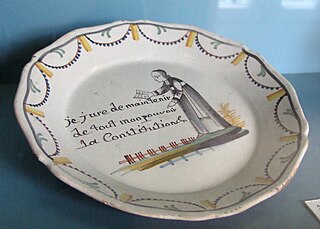
The Civil Constitution of the Clergy was a law passed on 12 July 1790 during the French Revolution, that sought the complete control over the Catholic Church in France by the French government. As a result, a schism was created, resulting in an illegal and underground French Catholic Church loyal to the Papacy, and a "constitutional church" that was subservient to the State. The schism was not fully resolved until 1801. King Louis XVI ultimately granted Royal Assent to the measure after originally opposing it, but later expressed regret for having done so.
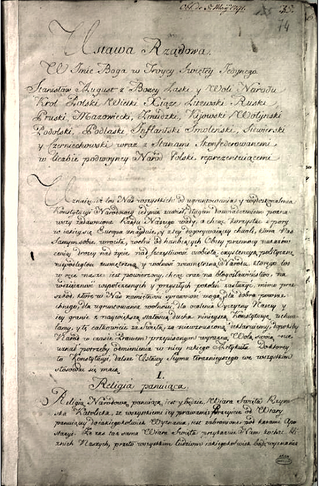
The Constitution of 3 May 1791, titled the Governance Act, was a constitution adopted by the Great Sejm for the Polish–Lithuanian Commonwealth, a dual monarchy comprising the Crown of the Kingdom of Poland and the Grand Duchy of Lithuania. The Constitution was designed to correct the Commonwealth's political flaws. It had been preceded by a period of agitation for—and gradual introduction of—reforms, beginning with the Convocation Sejm of 1764 and the ensuing election that year of Stanisław August Poniatowski, the Commonwealth's last king. It is the second constitution in history, after that of the United States.

Stanislaus of Szczepanów was Bishop of Kraków known chiefly for having been martyred by the Polish King Bolesław II the Generous. Stanislaus is venerated in the Roman Catholic Church as Saint Stanislaus the Martyr.

Hugo Stumberg Kołłątaj, also spelled Kołłątay, was a prominent Polish constitutional reformer and educationalist, and one of the most prominent figures of the Polish Enlightenment. He served as Deputy Chancellor of the Crown between 1791–92. He was a Roman Catholic priest, social and political activist, political thinker, historian, philosopher, and polymath.

The Great Sejm, also known as the Four-Year Sejm was a Sejm (parliament) of the Polish–Lithuanian Commonwealth that was held in Warsaw between 1788 and 1792. Its principal aim became to restore sovereignty to, and reform, the Commonwealth politically and economically.
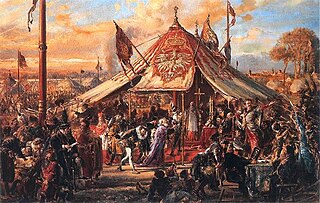
Royal elections in Poland were the elections of individual kings, rather than dynasties, to the Polish throne. Based on traditions dating to the very beginning of the Polish statehood, strengthened during the Piast and Jagiellon dynasties, they reached their final form in the Polish–Lithuanian Commonwealth period between 1572 and 1791. The "free election" was abolished by the Constitution of 3 May 1791, which established a constitutional-parliamentary monarchy.

The Polish–Lithuanian union was a relationship created by a series of acts and alliances between the Crown of the Kingdom of Poland and the Grand Duchy of Lithuania that lasted for prolonged periods of time from 1385 and led to the creation of the Polish–Lithuanian Commonwealth, or the "Republic of the Two Nations", in 1569 and eventually to the creation of a unitary state in 1791.
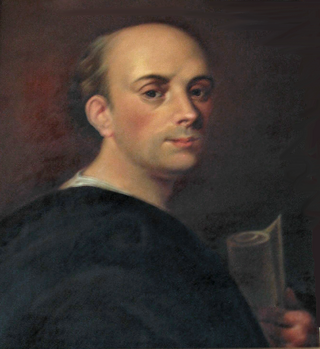
Scipione Piattoli was an Italian Catholic priest—a Piarist—an educator, writer, and political activist, and a major figure of the Enlightenment in Poland. After ten years as a professor at the University of Modena in Italy, he emigrated to the Polish–Lithuanian Commonwealth, where he became associated with several magnate families—the Potockis, Lubomirskis, and Czartoryskis. He was a member of Duchess Dorothea von Medem's court in Courland (Lithuania) and of King Stanisław August Poniatowski's court.

Rzeczpospolita is the official name of Poland and a traditional name for some of its predecessor states. It is a compound of the terms rzecz "thing, matter" and pospolita "common", a calque of Latin rés pública, i.e. republic, in English also rendered as commonwealth (historic) and republic (current).

The Constitution of the Republic of Poland is the supreme law of the Republic of Poland, which is also commonly called the Third Polish Republic in contrast with the preceding systems.

Religion in Poland is rapidly declining, although historically it had been one of the most Catholic countries in the world.

The Temple of Divine Providence and Pantheon of Great Poles (in Polish, Panteon Wielkich Polaków, in southern Warsaw's Wilanów district, is a principal Roman Catholic church in Poland. The backstory of its construction began in the 18th century. The Temple is conceived as a national and religious symbol for Poland. The complex comprises the Church of Divine Providence, the Museum of John Paul II and Primate Wyszyński, and the Pantheon of Great Poles.
A number of Catholic priests have served in civil office. The Catholic Church discourages this practice.
![]() Media related to 1791 in Poland at Wikimedia Commons
Media related to 1791 in Poland at Wikimedia Commons